
Georges Braque was a major 20th-century French painter, collagist, draughtsman, printmaker and sculptor. His most notable contributions were in his alliance with Fauvism from 1905, and the role he played in the development of Cubism. Braque's work between 1908 and 1912 is closely associated with that of his colleague Pablo Picasso. Their respective Cubist works were indistinguishable for many years, yet the quiet nature of Braque was partially eclipsed by the fame and notoriety of Picasso.

Pablo Ruiz Picasso was a Spanish painter, sculptor, printmaker, ceramicist, and theatre designer who spent most of his adult life in France. One of the most influential artists of the 20th century, he is known for co-founding the Cubist movement, the invention of constructed sculpture, the co-invention of collage, and for the wide variety of styles that he helped develop and explore. Among his most famous works are the proto-Cubist Les Demoiselles d'Avignon (1907) and the anti-war painting Guernica (1937), a dramatic portrayal of the bombing of Guernica by German and Italian air forces during the Spanish Civil War.

The Rose Period comprises the works produced by Spanish painter Pablo Picasso between 1904 and 1906. It began when Picasso settled in Montmartre at the Bateau-Lavoir among bohemian poets and writers. Following his Blue Period – which depicted themes of poverty, loneliness, and despair in somber, blue tones – Picasso's Rose Period represents more pleasant themes of clowns, harlequins and carnival performers, depicted in cheerful vivid hues of red, orange, pink and earth tones.
The Blue Period comprises the works produced by Spanish painter Pablo Picasso between 1901 and 1904. During this time, Picasso painted essentially monochromatic paintings in shades of blue and blue-green, only occasionally warmed by other colors. These sombre works, inspired by Spain and painted in Barcelona and Paris, are now some of his most popular works, although he had difficulty selling them at the time.

The Old Guitarist is an oil painting by Pablo Picasso, which he created in late 1903 and early 1904. It depicts an elderly musician, a haggard man with threadbare clothing, who is hunched over his guitar while playing in the streets of Barcelona, Spain. It is on display at the Art Institute of Chicago as part of the Helen Birch Bartlett Memorial Collection.
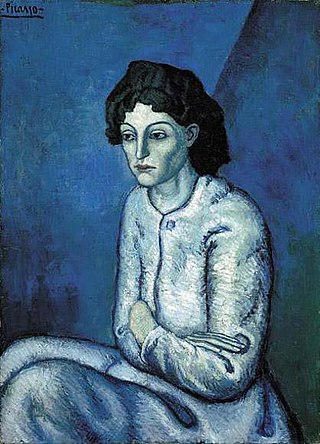
Femme aux Bras Croisés, is an oil on canvas painting by Pablo Picasso, which he created between 1901 and 1902 during his Blue Period. The subject of the painting is unknown, but she is considered to be an inmate of the Saint-Lazare hospital-prison in Paris. The painting is listed as one of the most expensive paintings after it achieved a price of $55 million at Christie's auction on 8 November 2000.
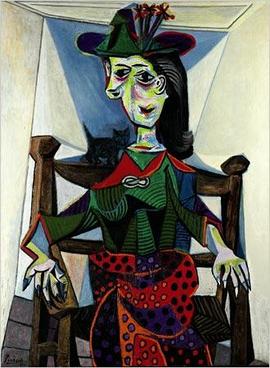
Dora Maar au Chat is an oil-on-canvas painting by Pablo Picasso. It was painted in 1941 and depicts Dora Maar, the artist's lover, seated on a chair with a small cat perched on her shoulders. The painting is listed as one of the most expensive paintings, after achieving a price of $95 million at Sotheby's on 3 May 2006. It is currently the sixth-highest-selling painting by Picasso.
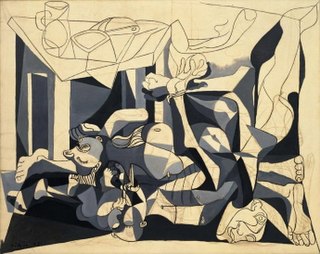
The Charnel House is an unfinished 1944–1945 oil and charcoal on canvas painting by Spanish artist Pablo Picasso, which is purported to deal with the Nazi genocide of the Holocaust. The black and white 'grisaille' composition centres on a massed pile of corpses and was based primarily upon film and photographs of a slaughtered family during the Spanish Civil War. It is considered to be the second of three major anti-war Picassos, preceded by Guernica in 1937 and succeeded by Massacre in Korea in 1951. The painting is housed in the Museum of Modern Art in New York City.
Bottle, Glass, Fork is an oil on canvas painting by Pablo Picasso (1881–1973). It was painted in the spring of 1912, at the height of the development of Analytic Cubism. Bottle, Glass, Fork is one of the best representations of the point in Picasso's career when his Cubist painting reached almost full abstraction. The analytic phase of Cubism was an original art movement developed by Picasso and his contemporary Georges Braque (1882–1963) and lasted from 1908-1912. Like Bottle, Glass, Fork, the paintings of this movement are characterized by the limited use of color, and a complex, elegant composition of small, fragmented, tightly interwoven planes within an all-over composition of broader planes. While the figures in Bottle, Glass, Fork can be difficult to discern, the objects do emerge after careful study of the painting. The painting is displayed in the Cleveland Museum of Art.

Family of Saltimbanques is a 1905 oil on canvas painting by Pablo Picasso. The work depicts six saltimbanques, a kind of itinerant circus performer, in a desolate landscape. It is considered the masterpiece of Picasso's Rose Period, sometimes called his circus period. The painting is housed in the collection of the National Gallery of Art in Washington, D.C.

Carles Antoni Cosme Damià Casagemas i Coll was a Spanish painter and poet. He is known for his friendship with Pablo Picasso, who painted several portraits of Casagemas. They traveled around Spain and eventually to Paris, where they lived together in a vacant studio.

La Vie is a 1903 oil painting by Pablo Picasso. It is widely regarded as the pinnacle of Picasso's Blue Period.
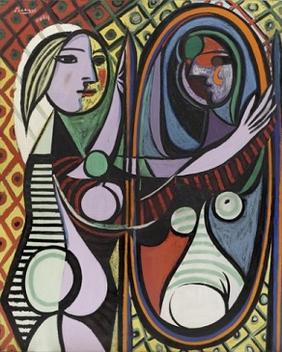
Girl before a Mirror(French: Jeune fille devant un miroir) is an oil on canvas painting by Pablo Picasso, which he created in 1932. The painting is a portrait of Picasso's mistress and muse, Marie-Thérèse Walter, who is depicted standing in front of a mirror looking at her reflection. It is housed in the collection of the Museum of Modern Art in New York City.

La Gommeuse is a 1901 oil-on-canvas painting by the Spanish artist Pablo Picasso. It dates from his Blue Period and is noted for its caricature of Picasso's friend Pere Mañach painted on the reverse. Gommeuse was sexually charged slang of the time for café-concert singers and their songs. It was offered for sale ex the William I. Koch collection at a Sotheby's, New York, auction on 5 November 2015. The painting realized $67.5 million at the sale, a record for a Blue Period Picasso, placing the painting among the most expensive ever sold.
Woman Ironing is a 1904 oil painting by Pablo Picasso that was completed during the artist's Blue Period (1901—1904). This evocative image, painted in neutral tones of blue and gray, depicts an emaciated woman with hollowed eyes, sunken cheeks, and bent form, as she presses down on an iron with all her will. A recurrent subject matter for Picasso during this time is the desolation of social outsiders. This painting, as the rest of his works of the Blue Period, is inspired by his life in Spain but was painted in Paris.

Au Lapin Agile is a 1905 oil on canvas painting by Pablo Picasso. It depicts the interior of the Lapin Agile, a famous cabaret club in the Montmartre area of Paris. The composition was produced during Picasso's Rose Period and includes a self-portrait of the artist who frequented the club in his youth. The painting is listed as one of the most expensive paintings after achieving a price of $40.7 million at Sotheby's auction on 27 November 1989. It is housed in the collection of the Metropolitan Museum of Art in New York City.
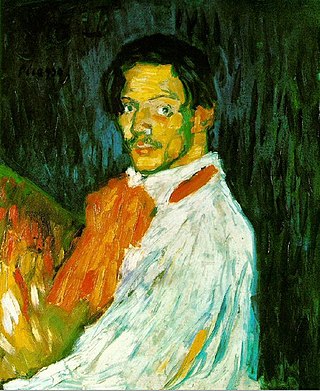
Yo, Picasso, is an oil-on-canvas painting by Pablo Picasso, which he painted in 1901. It is a self-portrait of the artist that depicts him in his youth, aged 19. The painting was created at the beginning of Picasso's Blue Period. On 9 May 1989, the painting sold at Sotheby's, achieving a price of $47.85 million, making it one of the most expensive paintings sold up to that date.
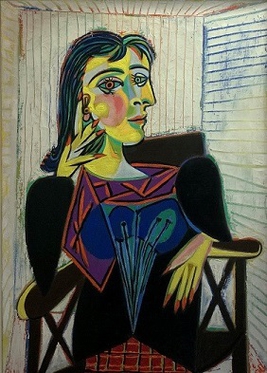
Portrait of Dora Maar is a 1937 oil on canvas painting by Pablo Picasso. It depicts Dora Maar,, the painter's lover, seated on a chair. It is part of the collection of the Musée Picasso, in Paris, where it is considered to be one of Picasso's masterpieces.

Portrait of Ambroise Vollard is an oil-on-canvas painting by Pablo Picasso, which he painted in 1910. It is now housed in the Pushkin Museum in Moscow. The painting is a representation of the influential art dealer Ambroise Vollard, who played an important role in Picasso's early career as an artist. It is painted in the style of Analytical Cubism, which Picasso pioneered.
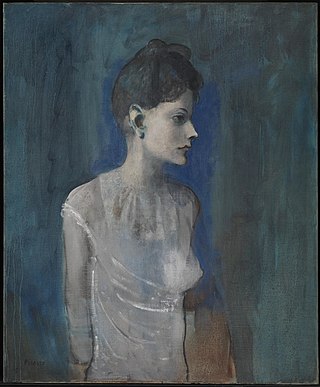
Girl in a Chemise is an oil-on-canvas painting created c. 1905 by Pablo Picasso. It is a portrait of a girl, whom experts believe to be Madeleine, Picasso's girlfriend during this period. Stylistically, the painting belongs to Picasso's Rose Period, although it is predominantly blue in tone. The painting is particularly remarkable for the presence of an earlier portrait of a young boy hidden beneath the surface, which Picasso transformed into the girl by making some subtle changes. The portrait has been housed in the collection of the Tate since 1933.

















